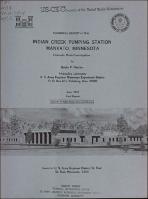Please use this identifier to cite or link to this item:
https://hdl.handle.net/11681/13272| Title: | Indian Creek pumping station, Mankato, Minnesota : hydraulic model investigation |
| Authors: | United States. Army. Corps of Engineers. St. Paul District Fletcher, Bobby P. |
| Keywords: | Entrances Fluid flow Hydraulic models Hydraulic structures Pumping stations Indian Creek Pumping Station Mankato, Minnesota |
| Publisher: | Cold Regions Research and Engineering Laboratory (U.S.) Engineer Research and Development Center (U.S.) |
| Series/Report no.: | Technical report (U.S. Army Engineer Waterways Experiment Station) ; H-78-8. |
| Description: | Technical Report Abstract: The model study was conducted to evaluate the characteristics of inflow to the original design gravity-flow section and pump sump and to develop modifications required for improving the distribution of flow to the gravity-flow section and pump intakes. The 1:10- scale model indicated the need for certain minor modifications to improve flow characteristics in the forebay and ensure satisfactory flow characteristics and pressures near the pump intakes. The major problems encountered at the pump intakes were generated by the concentrated jet entering and passing through the forebay. The concentrated jet produced adverse currents and turbulence near the pump intakes. Satisfactory approach flows were obtained by installing divider walls to isolate each pump. The major problems encountered at the entrance to the gravity-flow section were generated by the abrupt transition from the forebay to the gravity-flow section. The problems were alleviated by streamlining the entrance to the gravity-flow section. The improved flow conditions at the entrance to the gravity-flow section reduced the severe drawdown at the right abutment and provided a more direct route for flow to enter the gravity-flow section. The improved flow conditions to the pump intakes eliminated surface vortexes and reduced the pressure fluctuations from about 3.6 ft of water with the original design to 1 .0 ft of water with the recommended design. Freewheeling propellers, with zero pitch blades, located in the approximate position of the prototype pump propeller indicated a reduction in swirl from 7.6 rpm with the original design to 0.3 rpm with the recommended design. |
| Rights: | Approved for public release; distribution is unlimited. |
| URI: | http://hdl.handle.net/11681/13272 |
| Appears in Collections: | Technical Report |
Files in This Item:
| File | Description | Size | Format | |
|---|---|---|---|---|
| TR-HL-78-8.pdf | 7.25 MB | Adobe PDF |  View/Open |